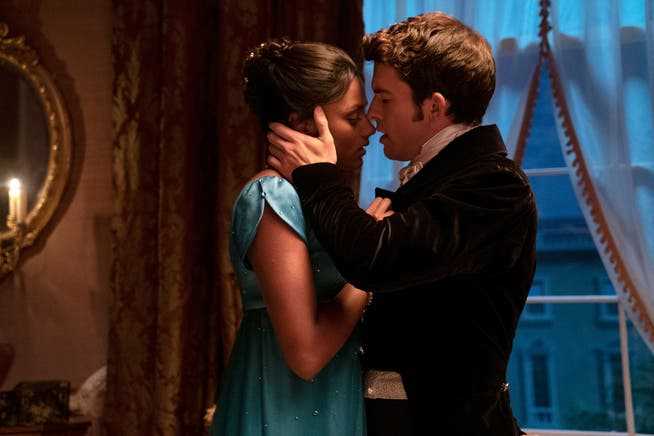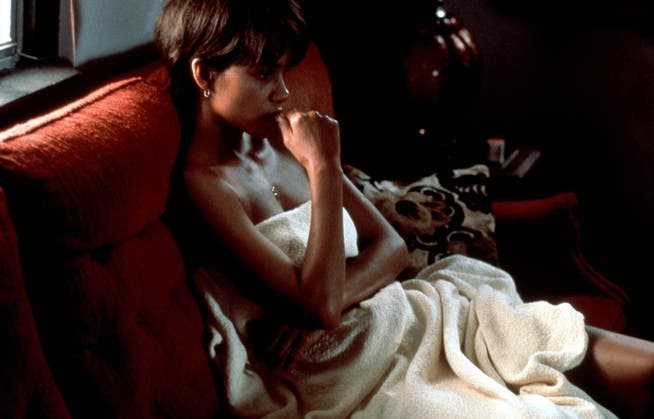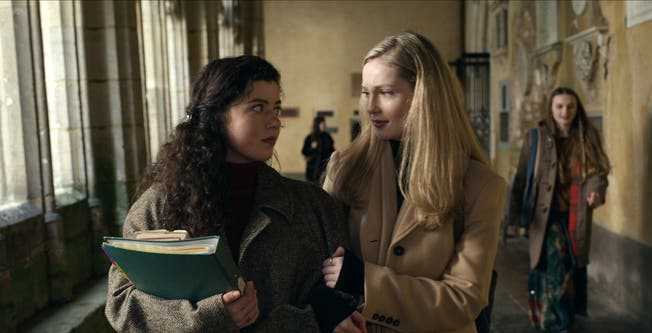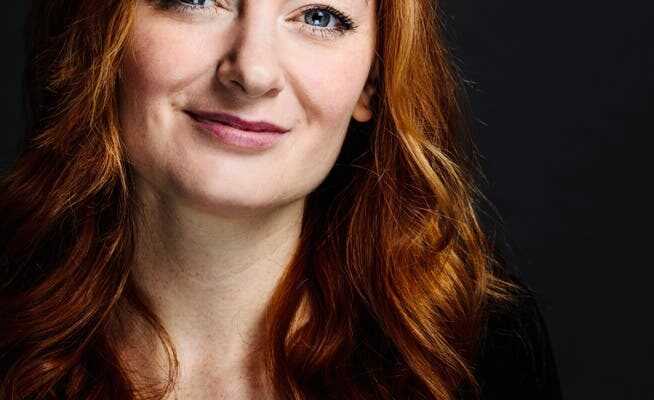Lizzy Talbot coordinates intimacy on “Bridgerton” and other Netflix productions. In doing so, she breaks with a principle that has always existed in the industry: improvisation.
Lizzy Talbot knows what it feels like to be an actress shooting intimate scenes. Today she coaches the actors in it.
Kate’s and Anthony’s lips are inches apart as she whispers, “I didn’t want this.” Anthony brushes a strand of hair out of her face and puts his hand on the back of her neck. “It’s unbearable,” he says. She breathes heavily: “Impossible.” Even before their lips meet, they let go of each other.
An actually unspectacular scene, after all it’s about nothing more than a broken kiss. But because of scenes like these, a fan cult has arisen around the Netflix series “Bridgerton”. It is the most successful product from Netflix. That should be less due to the average plot. According to reviews and social media, the series sets new standards when it comes to on-screen intimacy. Finally a series that shows credible intimate scenes, including sex scenes, and focuses on female lust, they say.
This is largely thanks to Lizzy Talbot.
British Lizzy Talbot is Intimacy Coordinator. That means: She choreographs and directs intimate scenes in front of the camera. With «Bridgerton», she meticulously planned every scene that required intimacy ranging from the spontaneous to the ecstatic. Even before the first take was taken, she had played through in her head precisely how much bare skin is needed, how the bodies should be positioned and where the actors will touch.
Talbot’s work is actually a paradox. She plans something you always thought couldn’t be planned: believable intimate scenes, the chemistry between the actors. Maybe it was naivety, maybe it was an excuse that while there were clear instructions for every other scene, the actors could be left to their own devices when it came to intimacy.

Kate (Simone Ashley) and Anthony (Jonathan Bailey) become very close in the second season of Bridgerton. Nothing is left to chance.
Violence is clocked through, intimacy remains without instructions
Lizzy Talbot’s job is about more than exposed sex. It’s about the physical integrity of the actors. Something that has gone unnoticed in the film industry for far too long. Talbot says: “I see myself as an advocate for the actors.”
Lizzy Talbot used to be in front of the camera herself. At the age of 18 she performs a kissing scene for the first time. The stage direction is brief: she should go down the hall with her partner and just “do something”. Talbot and her partner face each other and try to improvise. What could a good kiss look like? “It wasn’t traumatic, but it was a strange moment,” Talbot recalls today.
A little later she switched to the side of the choreographer and staged the course of fight scenes in films, often when domestic violence was to be depicted. The work makes her aware of a major imbalance on film sets: Scenes in which violence is depicted are clocked through, are intensively practiced, and the safety of the actors is a priority. The intimate scenes, on the other hand, appear to Talbot as a rule-free space in comparison.
What Talbot means by this becomes clear when actors who have had to shoot sex scenes without an intimacy coordinator tell about their experiences. “Monster’s Ball” was released in 2001, a drama with one of the most explicit sex scenes in recent film history. For several minutes, the actors Billy Bob Thornton and Halle Berry can be seen having raw, sometimes even violent, sexual intercourse. Berry will receive an Oscar for the film. She later said of the scene: “There were no real stage directions. The characters just had to have sex, and it had to look animalistic.” Thornton and she would have agreed to let go of all inhibitions and serve the characters – and then they would just go for it.

Halle Berry won an Oscar for her role in Monster’s Ball.
Sex scenes: a space of constant crossing of boundaries
It wasn’t until 2014 that a dancer named Ita O’Brien compiled guidelines for on-set intimacy and taught them to drama schools for the first time. Two years later, three actresses and choreographers found an organization for so-called intimacy directors. Lizzy Talbot joins this group and founds the British offshoot.
But nobody in the industry was waiting for the intimacy coordinators. Paying another person to influence the direction on the set and absorb the actors for additional rehearsals seems absurd to many.
“The industry will never change,” is a phrase Talbot often heard at the time. For decades, sex scenes have worked on the same principle: improvisation. Actors who clearly communicate their limitations are considered difficult. Hardly anyone sees that such a space is being created in which the boundaries are constantly being crossed. Today, Lizzy Talbot can hardly watch sex scenes from that time: “It sometimes feels like I’m watching an assault in real time.”
Then something happened in 2017 that nobody expected: the #MeToo movement shook the film industry to its foundations. Actresses report on experiences with attacks next to, but also on the film sets. In the same year, an intimacy coordinator is hired for the first time on a TV show – at the request of a cast member in the HBO series “The Deuce”. A year later, the company announces that it will never work without intimacy coordinators again. A turning point.
Actors shouldn’t get to know limits while shooting
But how exactly does an intimacy coordinator manage to plan erotic tension in a protected setting? How can what makes sex believable – spontaneity and ambiguity – be acted out in such a way that actors still feel safe? Talbot’s answer may seem sobering. A large part of her work is bureaucracy: reading the script, asking the director whether what is in it actually happens, going through the actors’ contracts in which they state what they don’t want to show and don’t want to do.
Then she asks the actors to sit down and write down again in detail where their limits lie in an intimate scene. “It can be banal things like ‘I don’t want my neck grabbed’ or ‘I don’t want to show my breasts’.” In this way, Talbot wants to find out to what point the protagonists feel safe – and thus prevent possible transgressions. “If the actors only find out during the shoot where their limits are, they may already have exceeded them,” says Talbot.
Now Talbot puts together a protocol with crash barriers for the shoot. She designs a choreography, thinks about possible positions and camera angles. And it determines where so-called “modesty garments” are used: garments and tapes that protect the genitals. She compares filming sex scenes to filming stunt scenes. “Only when the actors feel safe can they let go and concentrate on their role,” says Talbot.
If you ask Lizzy Talbot about the difficulties of her job, she says like a shot: “Acrobatics, water and corsets!” If you spin it in warm water, it loosens the glue on the «modesty garments». “And try undressing a laced corset erotically.”

Holly and Sophie as Oxford students in the Netflix series Anatomy of a Scandal.
Scenes of assault are hard to take even when acted out
The success of “Bridgerton” seems to prove Lizzy Talbot right. More and more production companies rely on intimacy coordinators on their sets. Their commitment is now tantamount to a seal of quality. The zeitgeist calls for the protection of actors. That may seem exaggerated or even unnecessary for comparatively harmless scenes of a loving couple like in “Bridgerton”. However, other series such as Anatomy of a Scandal, which Talbot recently worked on, illustrate how important physical approval can be on set.
In the recent Netflix success, the scene around which the entire series is built takes place in the walls of Oxford University. After a student party, the unassuming Holly and womanizer James meet late one night. As Holly tries to run away, James stops her by the hand. Holly seems torn as James kisses her gently on the nose, then on the mouth. She returns the kiss. Then James pushes her against the wall, lifts her skirt, rips her stocking. “Wait,” she says, trying to push him away. “Don’t play the prudish bitch,” he whispers, finishing what he started. For twenty long seconds the camera focuses on the assault, on Holly, who puts up with it.
From today’s perspective, it seems unthinkable that just a few years ago such scenes were shot without precise instructions from the director, without defined boundaries. Images of rape are heavy stuff, even when acted out. They are even harder to bear when it is not clear whether one is witnessing an assault.
Ultimately, it is questionable whether the sex scenes in “Bridgerton” actually appear more authentic than those known from other series such as “Game of Thrones”. It’s not the explicit depiction that sets sex scenes with an intimacy coordinator apart from the rest. Perhaps the true value for consumers lies in not having to worry about what is actually played.
